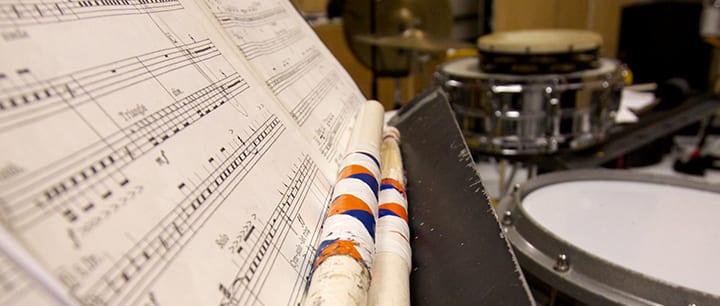
If you’re a drummer looking to take your skills to the next level, understanding drum sheet music is essential.
Drum sheet music can seem daunting at first, but once you understand the basics, it’s easy to learn more complex pieces and start reading music like a pro.
Let’s explore what drum sheet music is and how it works.
Is There Sheet Music for Drums?
Many drummers shy away from using sheet music, preferring instead to rely on their ear or memory to play their parts. However, there are several good reasons why drummers should consider using sheet music:
- For one thing, sheet music can provide a useful roadmap, helping you to learn a piece more quickly and efficiently.
- In addition, reading sheet music can help you to develop a better understanding of rhythm and meter.
- And finally, sight-reading skills can be useful in a variety of situations, from auditions to gigs with new bands.
So if you’re looking to improve your drumming skills, don’t overlook the benefits of using sheet music.
Not sure where to start when it comes to learning how to read drum music sheets? Ask your drum instructor for help! They can provide you with all kinds of assistance with this tricky task, along with other skills necessary for playing drums, like what you see in the video below:
https://www.youtube.com/watch?v=_6R2QeM3fBA
Is Drum Sheet Music Easy?
Drum sheet music may look daunting at first, but it is actually quite easy to read once you get the hang of it.
The key is to focus on the time signature and note values, which will tell you how fast or slow to play each beat. The notes themselves can be thought of as different “drum hits,” and they are typically written in order from left to right.
This corresponds to the order in which you would play the drums, starting with the left hand and moving to the right. While reading drum sheet music may take a bit of practice, it is not nearly as difficult as it seems at first glance.
With a little patience and perseverance, you’ll be reading drum sheet music like a pro in no time.
How to Read Drum Sheet Music: Step by Step
Think drummers don’t need to read music? Think again! Drum sheet music is a great way to learn your favorite beats and write things out so you will remember them later.
Drum sheet music is written on the same five line staff as traditional music. At the beginning of the piece, you’ll see the time signature. Written like a fraction (4/4 or 7/8, for example), the time signature lets you know how many beats to play in each measure and what the rhythm should be. You should also see the number of beats per minute above the staff, near the time signature. The beats per minute lets you know how quickly or slowly to play the beat.
Playing the Bass Drum
The bass drum, also known as the kick drum, is played by pressing a pedal with your right foot. Bass drum beats are noted in the first space on the staff as shown below:

For the hard rockers out there playing double bass drums, the second bass drum is shown on an imaginary line below the staff, like this:

Playing the Toms
Your three toms are written in the spaces above the bass drum. Play each tom by striking the drum in the center of the head with your stick. Avoid striking the rim of the drum as much as possible. The low tom is written in the second space, as seen in the example below:

Your mid-range tom, or mid tom, is shown as a note in the third space, as on the staff below:

Finally, the highest pitched tom, or hi tom, fills the top space on the staff.

Playing the Snare Drum
The snare drum’s snappy sound is essential for rock, pop, and jazz beats. You’ll see the snare show up on the third line of the staff, as in the example below:

If you’re familiar with the cross-sticking technique on the snare drum, you may see that method notated as on the staff below:

Playing the Hi Hat
You will often use the hi hat to keep time in rock and jazz beats. Hold the hi hat cymbals closed by using the pedal with your left foot and strike the cymbal with your stick. The hi hat shows up in the space above the staff, like in the example below:

You can also play the hi hat by opening and closing it with your left foot. When a piece calls for you to play the hi hat with your foot, it will appear as on the staff below:

Playing the Ride Cymbal
Like the hi hat, the ride cymbal is commonly used in rock and pop beats to keep time. You’ll see the ride cymbal appear on an imaginary line above the staff, as in the example below:
Where to Find Beginner Drum Sheet Music
If you’re a beginner drummer looking to improve your skills, you know how important it is to find the right drum music. You want sheets that are simple enough for you to keep up with and challenging enough to help you grow as a musician.
But where do you start? Don’t worry – we’ve got you covered. Here’s how to find drum sheet music for beginner drummers.
Online Resources
Thanks to the internet, finding drum sheet music has never been easier. There are tons of websites that offer free and paid-for sheet music specifically tailored towards beginners. Some even provide helpful video tutorials that show you exactly how the song should sound when played correctly. Plus, if there’s a particular artist or genre of music you like, chances are there’s sheet music available online that matches your tastes perfectly.
Music Stores
Don’t forget about your local music store! Many stores carry beginner-level drum sheet music in stock and can order any special requests they don’t have on hand. Plus, if you visit an actual store instead of buying online, the staff will be able to point out resources and give advice specific to your needs as a beginning drummer.
Whether it’s advice on technique or tips on which pieces will best challenge and improve your skills, their guidance can be invaluable for newbie musicians just starting out.
Books
If online resources and physical stores aren’t quite what you need, try checking out books from your local library or bookstore instead! Books dedicated entirely to beginner-level drum songs are plentiful and often include helpful diagrams or photos that make it easier for new players to catch onto each piece quickly and accurately.
Plus, since books tend to stay in print longer than individual sheets of music, they can be great investments if certain songs become staples in your repertoire over time!
More Tips for Reading Drumming Sheet Music
Learning how to read drum sheet music is an important part of becoming a successful drummer. Whether you’re just starting out or you’ve been playing for years, it’s essential that you understand the basics of drum notation so that you can effectively communicate with other musicians and expand your skills.
Here are some tips for reading drumming sheet music like a pro.
Understand the Basics of Drum Notation
The first step in learning how to read drum sheet music is understanding the basics of drum notation. The clef at the beginning of the staff indicates which notes correspond to which drums and cymbals, and there may also be symbols above the staff indicating which techniques (rolls, flams, etc.) should be used.
Once you understand how different notes correspond to different drums or cymbals, you can begin interpreting what each note means and how it should be played.
Learn Common Rhythmic Patterns
Once you understand the basics of drum notation, it’s important to learn some common rhythmic patterns that will help you build speed and accuracy while reading drum sheet music. For instance, many rhythms are based around eighth notes followed by sixteenth notes; knowing this pattern can help make difficult passages easier to read. Additionally, learning common patterns such as paradiddles and flams can help develop your technique and improve your speed when playing through complex passages.
Practice Reading Sheet Music Daily
Finally, practice makes perfect! To become proficient at reading drum sheet music, it’s important to practice daily so that you can become comfortable with understanding what individual notes mean and how they should be interpreted on the drums. Set aside time each day to practice sight-reading different pieces so that you can improve your skills over time.
Drum Songs Sheet Music for Beginners – One Last Tutorial
Now that you’re familiar with all the pieces of the sheet music puzzle, let’s put them together and do some reading! This video from Android drum app Adictum shows a piece of sheet music and plays the accompanying drum sounds. Follow along and practice recognizing the notes and drum sounds.
Ready to try playing drum sheet music on your own? Online Drummer is a great resource for finding drum music. They offer a wide variety of free and paid sheet music, as well as some video tutorials.
Learning how to read drum sheet music can seem overwhelming at first glance but it doesn’t have to be difficult! Once you become familiar with all the different symbols used in this type of notation, you’ll soon find yourself unlocking all sorts of complex rhythms and challenging pieces. So grab those sticks and get started today—you could soon be reading like a pro!
View all Takelessons.com Free Sheet Music Resources.
You might also like…
–5 No-Nonsense Tips for Drum Practice
–Be a Musician, Not a Drummer – Part 1
–Drum Exercise: Grooving with Different Genres and Styles
-Megan L. TakeLessons Staff Member and Blogger
Photo by jblaha
Megan L.


